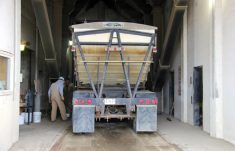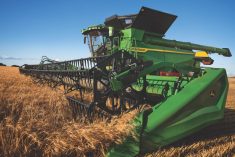CNS Canada — Canada’s Farm Input Price Index has climbed slightly for the first quarter of this year.
Canada-wide, the index rose 1.3 per cent for the first quarter of this year compared to the final quarter of 2016. When comparing this year’s first quarter to last year’s first quarter, however, input prices in the survey fell 1.4 per cent.
The Statistics Canada report attributed the increase for the first quarter of 2017 over the final quarter last year to higher costs in animal production, which rose 2.8 per cent. Most of that was due to livestock purchases, which were up 5.2 per cent, the report said.
Read Also

USDA cuts US corn stocks outlook after raising exports to record high
The U.S. Department of Agriculture lowered its U.S. corn supply forecast in a monthly supply-and-demand report on Friday and raised its outlook for U.S. exports of the grain this season to a record high following a strong pace of overseas shipments.
“The biggest thing that we had noticed was the hog prices, which had significant upward movement,” Roland Hebert, a StatsCan analyst, said in a phone interview.
That’s similar to what was shown in data from the U.S., he added.
StatsCan’s Farm Input Price Index is designed to provide an indication of input cost changes faced by Canadian farmers and can be useful in pointing out trends. The index collects administrative prices on a selection of inputs. Individual farmer prices may vary.
On the Prairies, Manitoba and Saskatchewan input prices increased the most from the fourth quarter of 2016 to the first quarter of 2017, at 2.1 per cent and 1.8 per cent, respectively. Alberta’s increased 1.3 per cent.
“But here in particular in Saskatchewan (and Manitoba) we have seen significant movement for seed and, as I mentioned, for hogs. They had very large movement, so I think it would be safe to say there is an upward trend in those two components that might be driving up the cost of farming,” Hebert said.
However, compared to the first quarter a year ago, Alberta was actually down the most of any province in the nation, at 5.6 per cent.
Among other key points in the report:
In the four western provinces combined, the Farm Input Price Index rose 1.6 per cent in the first quarter of 2017 from the final quarter of 2016. The index fell 2.2 per cent compared to the first quarter of 2016.
Manitoba producers saw the largest increase (Q4 2016 to Q1 2017) at 2.1 per cent. The province had a decline of 0.3 per cent in its 2017 Q1 from the year-earlier period.
Saskatchewan producers saw an input increase of 1.8 per cent (Q4 2016 to Q1 2017) and 0.4 per cent compared to the same quarter a year ago.
Alberta producers saw an increase of 1.3 per cent fourth-to-first quarter increase and a decline of 5.6 per cent when the first quarters of 2017 and 2016 are compared.
British Columbia’s farm price index climbed 1.7 per cent from Q4 2016 to Q1 2017 and rose 2.2 per cent compared to the same quarter last year.
Nationally, for the first quarter 2017 compared to the final quarter of 2016, the index reports that machinery and motor vehicle sales rose two per cent, crop production costs rose 0.4 per cent, and buildings climbed 0.3 per cent. General business costs fell 0.5 per cent.
— Terry Fries writes for Commodity News Service Canada, a Winnipeg company specializing in grain and commodity market reporting.
















